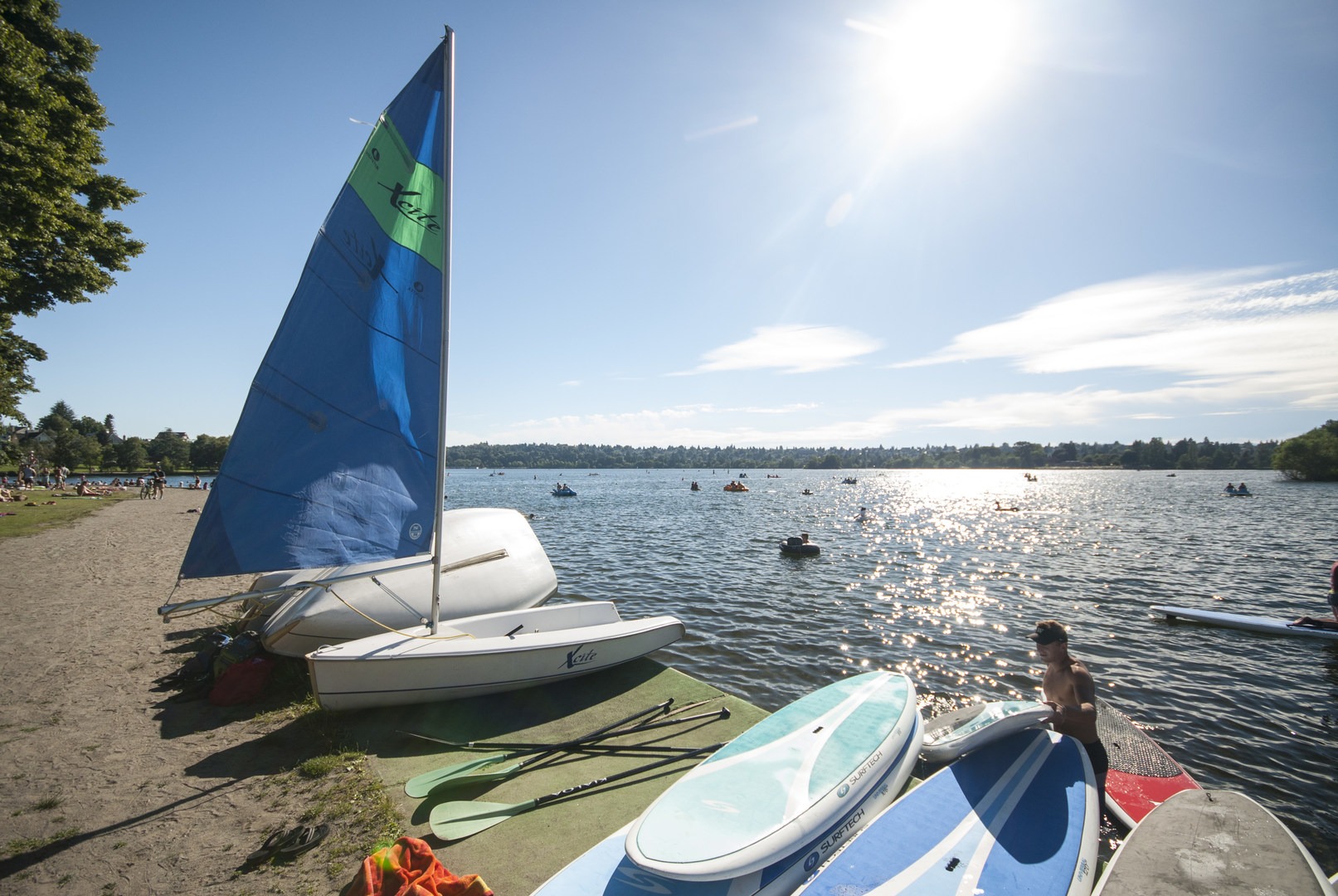You are here
Created in 1911 when Green Lake was drained and lowered an additional 7 feet, Green Lake Park has been one of Seattle's most iconic destinations ever since.
The idea for the park was envisioned in 1903 as part of Seattle's Olmsted* Plan, a grand landscape plan in which parkland and green spaces would interconnect the entire city. Today, the park encompasses the perimeter of 259-acre Green Lake and abuts the northern boundary of Woodland Park to it's south.
Amenities
The park's most notable amenities and facilities include:
- The Bathhouse, built in 1927, which once served as an outdoor swimming pool is now a venue for the Seattle Public Theater.
- Green Lake Community Center, built in 1929, and Evans Pool. The center includes conference rooms, a gymnasium, bathrooms, and a stage. Open Monday through Saturday. Call 206.684.0780 for details and reservations.
- Children's wading pool.
- East + West Green Lake Beach + Swimming Area.
- 5 tennis courts (3 on the east side, 2 on the west side).
- 1 basketball court.
- Sports field, popular for baseball, soccer, kickball, and volleyball (courts are set up during the summer months).
- 2.8-mile long Green Lake Inner Loop Trail (paved).
- 3.2-mile long Green Lake Outer Loop Trail (non-paved).
- Green Lake Boat Rentals.
- Green Lake small craft center. Home and storage facility for Green Lake Crew and the Seattle Canoe and Kayak Club.
- Green Lake Pitch 'n Put. A nine-hole par-three open from March through the end of October. Call 206.632.2280 for more details.
- Remnant of the Green Lake Aqua Theater.
Perhaps more than any other amenity at Green Lake Park, the Aqua Theater has the most interesting story. According to Wikipedia:
The Green Lake Aqua Theater was built in 1950 for the first Seafair in order to house an attraction called the Aqua Follies and their "swimusicals," a combination of aqua ballet, stage dancing, and comedy. The theater included a round stage and floating (though still recessed below the stage) orchestra pit, encircling a section of the lake with high diving platforms on each side. The grandstand capacity was more than 5,000 seats. The Aqua Follies continued to run during Seafair until 1965. Outside of the Seafair schedule the theater was the stage for plays and musicals whose directors always took advantage of the unique setting. In the summer of 1962, coinciding with the Century 21 Exposition, the Aqua Theater stage was host to a jazz festival, popular performers such as Bob Hope, two plays, and a special presentation of the Aqua Follies with 100 performers. After the World's Fair, summer productions languished, which is usually blamed on Seattle's unpredictable weather, until the Aqua Theater was mostly abandoned. A 1969 concert by the Grateful Dead revealed that the grandstand was crumbling and dangerous. Beginning in 1970 the theater was dismantled, stage right now serving as a pedestrian pier and stage left providing dock and storage for crew shells. Some sections of the grandstand were left in place.
Events
JUNE:
- Gaelic Games Tournament. Early June.
- Green Lake Open Water Swim. Half-mile and 1-mile race. Late June. Call 206.684.4961 for details.
JULY:
- Seafair and Milk Carton Derby. Starting in early July as a part of Seattle's city-wide Seafair, the Milk Carton Derby is one of Green Lake's most celebrated events. Creative and flashy boats were originally crafted from old milk cartons. Today, the rules for using milk cartons is more loosely applied.
NOVEMBER:
- Green Lake Crew Frostbite Regatta. Early November.
- Green Lake Gobble 5K/10K Run/Walk and Mashed Potato Munch Off. Sunday before Thanksgiving.
* Brought to the national stage after the improvement design of New York's Central Park, the "Olmsted" brand gained mass appeal. The Olmsted Brothers were commissioned to create park masterplans for countless U.S. cities, including Portland, where they envisioned the nation's largest urban park, Forest Park. Interestingly, Central Park was actually designed by Frederick Law Olmsted and his business partner, Calvert Vaux, in 1858. Their landscape architecture firm would later be passed down to his son and step-son, Frederick Law Olmsted Jr. and John Charles Olmsted, who would ultimately be known professionally as the Olmsted Brothers.
Logistics + Planning
Current Weather: Powered by Dark Sky
























Comments
Sign In and share them.